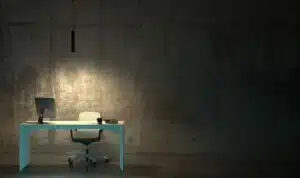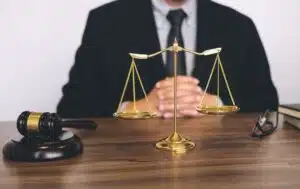Did you suffer an injury in a trip or fall because of poor or inadequate light in your workplace? If so, you might wonder ‘When are you able to claim for poor lighting in the workplace that caused an accident and injury?’. This guide explores when you could be eligible to seek personal injury compensation claim following an accident at work that left you injured. It also discusses how long you have to start legal proceedings.
Additionally, we look at the duty of care owed by employers to employees and how a breach can occur when lighting standards are not met.
Later, we discuss how compensation for workplace accident claims is calculated and what a payout could cover to address the impacts of your injuries. We conclude our guide by explaining the advantages of starting a personal injury claim with a solicitor from our panel using a type of No Win No Fee contract.
You can talk about your potential inadequate lighting compensation claim with our team by filling in our contact form and requesting a call-back. Alternatively, continue reading to find out more about claiming accident at work compensation for your injuries.
Jump To A Section
- When Are You Able To Claim For Poor Lighting In The Workplace?
- How Could Poor Lighting At Work Be The Result Of Employer Negligence?
- Is There A Time Limit When Making A Claim For Poor Lighting In The Workplace?
- Potential Compensation From Poor Lighting Claims
- Make A No Win No Fee Claim For Injuries Caused By The Effects Of Poor Lighting
- More Resources About Claiming For Injuries Caused By Poor Lighting In The Workplace
When Are You Able To Claim For Poor Lighting In The Workplace?
The duty of care placed on employers is outlined in the Health and Safety at Work etc. Act 1974.(HASAWA). This is the central piece of workplace health and safety legislation. It states that all employers should take practicable and reasonable steps to ensure that employees are prevented from harm at work and as they do their jobs. Amongst other actions, this includes conducting regular assessments of risk in the work areas as well as ensuring that the work environment is safe by addressing any hazards that pose a risk of injury.
In addition to HASAWA, other pieces of legislation provide specific information on the steps employers must take to protect employees health and safety. For example, Section 8 of the Workplace (Health, Safety and Welfare) Regulations 1992 states that every workplace must have suitable, sufficient, and adequate lighting.
If there is a failure to meet this health and safety requirement resulting in poor or missing lighting in your workplace causing an injury, you might want to claim compensation.
There are eligibility criteria that dictate when you are able to claim for poor lighting in the workplace. You must be able to show that negligence occurred. In tort law, this means:
- You were owed a duty of care by your employer at the time and place of the accident.
- This duty was breached by your employer.
- You suffered a physical and/or psychological injury due to the breach of duty.
All three points must apply for you to have a valid personal injury claim. To discuss your specific case and find out whether you have a valid compensation claim, contact an advisor today. They could connect you with a personal injury solicitor if you have eligible grounds to proceed.
How Could Poor Lighting At Work Be The Result Of Employer Negligence?
Poor or inadequate lighting in the workplace can create numerous hazards. Examples of how it could result in an accident at work include:
- An office worker could suffer an ankle dislocation after tripping on cables in a poorly lit office.
- A factory worker could suffer a serious head injury after colliding with a low ceiling light that was not properly lit and no warning signs were placed to warn of the inadequate lighting hazard.
- Poor workplace lighting in a stairwell could cause a slip, trip and fall accident that results in an employee sustaining a severe back injury and broken bones.
There can be other scenarios where a lack of correct lighting leads to you suffering an injury, such as through a lack of regular risk assessments. If you would like to discuss the specifics of your potential claim, please contact our dedicated advisors. They can provide further guidance on the question ‘When are you able to claim for poor lighting in the workplace that caused an accident?’.
Is There A Time Limit When Making A Claim For Poor Lighting In The Workplace?
Generally, there is a three-year time limit that applies to personal injury claims as outlined by the Limitation Act 1980. This means you have three years from the date of the accident to start legal proceedings. Under certain circumstances, the time limits can vary, for instance:
- Injured people under 18 cannot make a claim themselves. As such, the time limit is paused and the court can appoint a litigation friend to start the claim for the child during this time. If a claim is not submitted on their behalf by the time the child turns 18, they will have three years starting from the date of their 18th birthday to launch a claim independently.
- Claimants who lack mental capacity cannot claim for themselves and the time limit is suspended completely. A litigation friend may also launch a claim on their behalf. If the person regains their mental capacity, the three-year time limit starts from the date they recovered.
For more information on the time limits for personal injury claims and the exceptions that can apply, please speak to our team for free.
Potential Compensation From Poor Lighting Claims
After a successful accident at work claim, your settlement could be made up of two heads of claim. Firstly, general damages compensate the claimant for the physical pain caused by their injuries, as well as any psychological suffering experienced.
To help value general damages, you might be asked to attend an independent assessment with a medical professional as part of the personal injury claims process. They can provide a report that details your level of harm. It also provides supporting evidence in your case.
The report can be used alongside a publication called the Judicial College Guidelines (JCG) which lists award brackets for different types of injuries. You can find some of these figures in the table below, with the exception of the first entry.
Award Guidelines
Please use these figures as a guide only. Settlements for each inadequate lighting injury claim can differ depending on the specific circumstances of your case.
| Type of Injury | Level of Severity | Notes | Award Bracket - Guidelines |
|---|---|---|---|
| Multiple Severe Injuries and Special Damages | Severe | Compensation for the pain and suffering of multiple severe injuries and the incurred financial losses they caused, such as lost income, care costs and medical bills. | Up to £1 million plus |
| Head | (b) Moderately Severe | A very serious disability. This could be physical, including paralysis, or cognitive, including marked intellect and personality impairment. The person is substantially dependent on others and needs constant professional care. | £219,070 to £282,010 |
| (c) Moderate (iii) | Cases where memory and concentration are affected and ability to work is reduced. Dependence on others is limited. | £43,060 to £90,720 | |
| Knee | (a) Severe (i) | Cases of a serious knee injury that disrupt the joint and cause several issues, such as osteoarthritis development, considerable pain and loss of function, and lengthy treatment. | £69,730 to £96,210 |
| (b) Moderate (i) | Injuries that involve dislocation or torn cartilage/meniscus resulting in weakness, wasting and other mild forms of disability. | £14,840 to £26,190 | |
| Leg | (b) Severe (ii) | Very serious injuries that lead to permanent mobility problems and create the need for mobility aids or crutches from that point onwards. | £54,830 to £87,890 |
| (c) Less Serious (i) | Cases where there are serious soft tissue injuries or fractures that don't completely recover. | £17,960 to £27,760 | |
| Ankle | (a) Very Severe | A bilateral ankle fractures that results in joint degeneration at a young age. | £50,060 to £69,700 |
| (c) Moderate | Fractures and ligamentous tears that create disabilities that are considered less severe such as difficulty standing for a prolonged period, walking on uneven ground and awkwardness on stairs. | £13,740 to £26,590 | |
| Back | (a) Severe (iii) | Instances of fractures to discs or disc lesions and soft tissue injuries that can give rise to chronic conditions. | £38,780 to £69,730 |
| (b) Moderate (i) | Cases that include crush and compression fractures in the lumbar vertebrae that give rise to a substantial risk of constant pain and osteoarthritis. | £27,760 to £38,780 |
When Can You Claim For Financial Losses Caused By Poor Lighting?
The second head of claim is special damages. This awards compensation to reimburse the claimant for past or future financial losses or expenses caused by the injuries. For example:
- Loss in earnings because you were unable to work.
- Care costs.
- The cost of home or vehicle renovations.
- Travel costs.
- Medical bills.
Evidence in the form of receipts, payslips, and invoices, can help prove these losses. As such, be sure to keep hold of any documentation that can support your claim.
For further guidance on how much compensation could be awarded for your injuries caused by poor lighting at work, call our team. They can offer a free valuation of your potential workplace injury claim.
Make A No Win No Fee Claim For Injuries Caused By The Effects Of Poor Lighting
Although you are free to represent yourself in a compensation claim, you might find it easier with a personal injury solicitor at your side. They can offer several services, including helping you gather evidence to strengthen your case, such as medical evidence, pictures of your visible injuries and the accident scene, and contact details of witnesses so a witness statement can be taken at a later date.
To see if you might qualify to work with one, take the first step of speaking to our advisors. They can assess your case to determine if you are able to claim for poor lighting in the workplace and if you are, may connect you with one of the experienced solicitors from our panel.
The solicitors on our panel offer their services via a No Win No Fee contract called a Conditional Fee Agreement (CFA). Under a CFA, there are no fees to pay for the solicitor’s services upfront, during the course of the claim, or if the claim fails.
If your claim succeeds, your solicitor will take a percentage of your compensation. This is to cover the solicitor’s success fee. However, the percentage they can take has a legal cap ensuring you receive the most of your compensation payout.
To find out more about how a No Win No Fee solicitor can help with workplace accident claims for injuries caused by poor lighting, please contact an advisor by filling out our contact form to request a call-back.
More Resources About Claiming For Injuries Caused By Poor Lighting In The Workplace
Below, we have provided some additional guides relating to workplace accident claims:
- This guide explores if your employer can sack you after an accident at work.
- Information on steps that can help prevent an accident in the workplace and how employers can uphold their duty of care.
- This guide explores how to find serious injury solicitors to help you.
Additionally, we have provided some external resources that may help:
- Helpful slip prevention advice from the Health and Safety Executive (HSE).
- Guidance on first aid from the NHS.
- Information about Statutory Sick Pay (SSP) from the GOV.UK.
Thank you for reading this guide answering the question ‘When are you able to claim for poor lighting in the workplace?’. If you need any other information about how to claim personal injury compensation, please contact an advisor using the details provided above.





